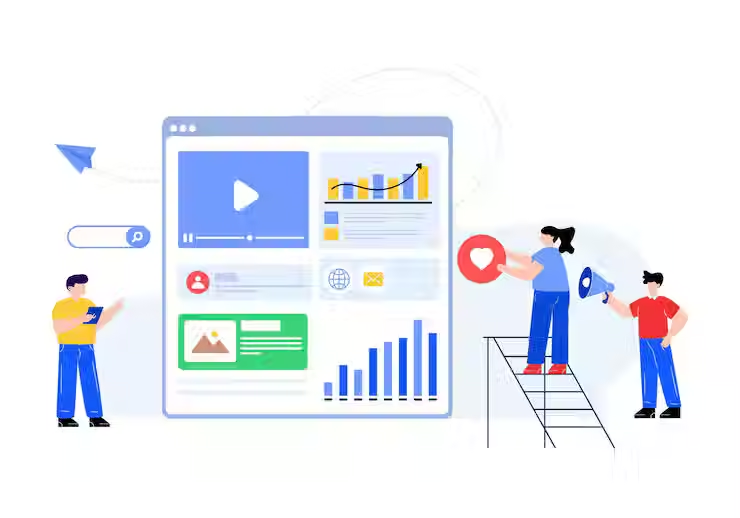What is Traffic in Digital Marketing: Unveiling Its Importance and Impact
- Admin

- Jun 3
- 6 min read
In the fast-paced world of digital marketing, "traffic" is more than just a buzzword; it’s the lifeblood of any successful online strategy. Every click, visit, and interaction provides valuable insights into consumer behavior, preferences, and the effectiveness of a marketing campaign. In this post, we will clarify what traffic means in digital marketing, explore its types, sources, and highlight why it is essential for anyone looking to build or improve their online footprint.
What is Traffic in Digital Marketing?

Traffic in digital marketing refers to the number of visitors that access a website or digital platform within a defined timeframe. This can be quantified in different ways, including unique visitors, page views, or sessions.
Traffic goes beyond merely counting visitors; it captures essential details about user behavior, preferences, and how well a website achieves its goals. For instance, if a website reaches 1,000 unique visitors a month, monitoring traffic patterns can reveal which marketing efforts are paying off and where improvements can be made.
Types of Traffic
Recognizing the different traffic types is fundamental for shaping a successful digital marketing strategy. The main types of traffic include organic, direct, and paid traffic.
Organic Traffic
Organic traffic consists of visitors who reach a website through unpaid search results. This traffic arises when a website ranks well for targeted keywords, attracting visitors without spending on advertisements.
For example, if a local bakery optimizes its site for keywords like "best sourdough bread," it may appear on the first page of search results and attract dozens of customers each week without any ad spend. Organic traffic is cherished for its low cost and long-term sustainability; a successful SEO strategy can continue bringing in traffic for years.
Direct Traffic
Direct traffic includes visitors who enter a website URL directly into their browser or access the site via bookmarks. This type of traffic is a strong indicator of brand loyalty, as users are often already familiar with the brand and its offerings.
Imagine a popular online course provider that garners a considerable amount of direct traffic because satisfied customers bookmark their site after completing a course. This highlights that retaining existing customers can result in ongoing visits and brand advocacy.
Paid Traffic
Paid traffic consists of visitors gained through advertisements, such as pay-per-click (PPC) campaigns on search engines and social media platforms. Businesses utilize paid ads to rapidly boost visibility, especially during time-sensitive promotions.
For example, a new product launch might involve a PPC campaign that drives 500 visitors within the first week, leveraging targeted ad placements to reach potential buyers quickly. While this requires a financial commitment, the return on investment can lead to significant revenue generation.
Traffic Sources
Understanding where traffic comes from can drastically enhance marketing efforts. The primary sources include:
Search Engines: Sites like Google, Bing, and Yahoo deliver organic traffic. For instance, Google handles over 3.5 billion searches daily, housing immense potential for organic leads.
Social Media Platforms: Traffic from platforms such as Facebook, Twitter, and Instagram can fluctuate based on how engaging the content is. Organic posts and paid ads can create substantial traffic spikes.
Referrals: Other websites that link to your content can drive traffic and enhance credibility. For instance, a mention in a popular blog can lead to thousands of visitors if the link encourages clicks.
Email Marketing: Sending well-targeted emails, such as promotional offers or newsletters, can result in significant traffic boosts. A compelling call to action can persuade readers to visit your site.
By focusing on these sources, marketers can refine campaigns to maximize traffic from the most beneficial avenues.
The Importance of Traffic
Traffic is more than a number; it’s a crucial metric for evaluating a website's performance. Here are a few reasons why traffic should be a key focus:
Conversions and Revenue
More visitors typically lead to more conversions. Whether that means signing up for a newsletter or making a purchase, increased traffic creates greater opportunities for generating revenue. For example, when an online retail store doubles its monthly traffic from 5,000 to 10,000 visitors, it could realistically expect a proportional increase in sales, potentially raising revenue by 20 to 30 percent.
Brand Visibility
A website with substantial traffic often ranks higher on search engines. This increased visibility strengthens brand recognition, where customers are more likely to trust and engage with brands they see consistently.
For example, studies show that the top few results in Google search results receive over 70% of clicks, meaning that better traffic translates directly into enhanced brand visibility.
User Insights
Traffic analytics provide priceless insights into user behavior. By examining factors like bounce rates and session duration, businesses can understand what content captivates their audience. For instance, if visitors stay on a blog for an average of five minutes, it indicates that the content is engaging. However, a high bounce rate on product pages might prompt the need for content adjustments to keep visitors interested.
Strategies to Increase Traffic
Boosting traffic is an attainable goal with the right strategies. Here’s how:
Search Engine Optimization (SEO)
SEO is one of the most effective ways to increase organic traffic. By optimizing website content and structure, businesses can improve their search engine rankings. This can include keyword research, on-page adjustments, engaging content creation, and acquiring backlinks. For example, a small business that spends time optimizing its site (potentially with help from a SEO Expert in India) can experience a traffic increase of 50% over six months.
Content Marketing
Quality content is vital for drawing in and retaining visitors. Regular updates through blogs, infographics, and videos can keep users engaged and encourage repeat visits. Consider a travel agency that publishes regular articles about destinations and travel tips, resulting in a higher engagement rate and drawing hundreds of new visitors monthly. Implementing these strategies effectively might involve partnering with a skilled Digital Marketing Freelancer In India.
Social Media Engagement
Maintaining an active social media presence can significantly increase traffic. Sharing valuable and engaging content can entice users to click through to the website. For instance, a restaurant that regularly posts mouthwatering images of dishes may attract food lovers to their site for reservations or menus, raising traffic efficiently.
Email Marketing
Building a robust email list can result in considerable direct traffic. Including links to website content in newsletters and promotional emails encourages readers to visit. For instance, a monthly newsletter that features a new blog post or special offer can lead to a measurable boost in website visits, potentially increasing traffic by 15% each month.
Pay-Per-Click (PPC) Advertising
Running targeted PPC campaigns, potentially through specialized PPC Services In India, can yield immediate traffic. Businesses can tailor ads to meet specific demographics, ensuring their message reaches the intended audience effectively. For example, local businesses might utilize a PPC campaign targeting their geographic area, significantly increasing foot traffic to their physical locations.
Evaluating Traffic Success
To assess the effectiveness of your digital marketing efforts, measuring traffic is essential. Consider these key metrics:
Unique Visitors
This counts distinct users throughout a specified period, helping you to gauge how far your audience reaches. For example, a rise from 800 to 1,500 unique visitors in a month signals progress.
Page Views
Analyzing page views indicates user interest. A site experiencing an increase in page views generally implies visitors are exploring various sections. Conversely, consistently low numbers might call for reevaluation of content quality.
Bounce Rate
The bounce rate represents the percentage of visitors who leave after viewing only one page. A bounce rate above 70% could indicate that users do not find what they are looking for, signaling a need for content or design improvements.
Time on Site
Monitoring how long visitors stay can provide insights into content effectiveness. A high average time indicates engaging material, suggesting that visitors are finding value in what they are reading.
Harnessing Analytics Tools
Utilizing analytics tools is essential for gaining insights into traffic sources and user behavior. Tools like Google Analytics provide real-time data that allows marketers to adjust their strategies effectively.
Through analyzing this data, businesses can pinpoint what works and what doesn’t, allowing for refined and better-performing digital marketing campaigns.
Setting Clear Goals and KPIs
Establishing specific goals and key performance indicators (KPIs) helps track traffic effectively. Whether aiming for a 20% increase in monthly traffic or a desired conversion rate, measurable objectives allow you to assess progress realistically.
Common Challenges in Traffic Management
Despite the many advantages, managing traffic can present challenges. Some common hurdles include:
Fluctuating Traffic Trends
Traffic can shift based on trends, seasonality, or algorithm changes from search engines. Marketers must stay ahead of the curve and adapt their strategies accordingly to maintain a consistent flow.
Competition
In competitive markets, achieving high rankings for desired keywords can be increasingly tough. Continuous optimization and innovative content strategies become essential for standing out.
Budget Constraints
Limited budgets may restrict the ability to invest in paid ads or sophisticated analytics tools. Businesses must prioritize where to allocate resources effectively.
Unlock Your Search Potential with Schema Markup
Grasping the concept of traffic in digital marketing is essential for any brand hoping to succeed in the digital arena. By understanding the various traffic types, sources, and their significance, marketers can devise strategies that amplify their online visibility.
By focusing on consistent SEO practices, creating valuable content, and engaging audiences through social media and email, traffic growth becomes attainable. Through diligent measuring and smart use of analytics tools, businesses can tailor their digital marketing approaches to maximize effectiveness.
Navigating the complexities of traffic growth may seem challenging, but this journey is vital for any brand eager to thrive online. The insights derived from traffic data not only fuel growth but ensure lasting sustainability in the ever-changing digital landscape.







Comments